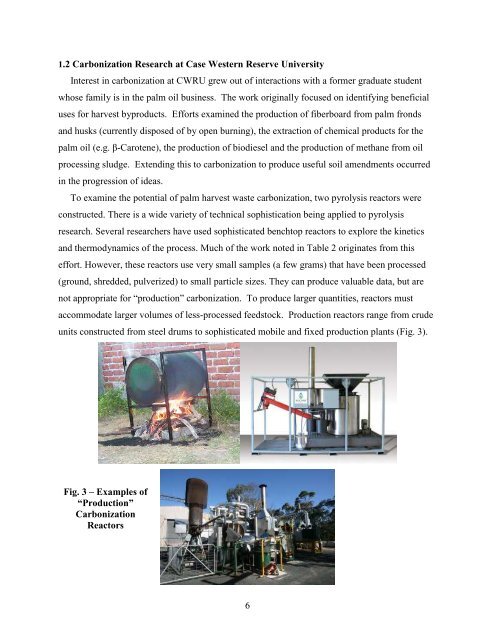Final Report - Ohio Department of Transportation
Final Report - Ohio Department of Transportation
Final Report - Ohio Department of Transportation
Create successful ePaper yourself
Turn your PDF publications into a flip-book with our unique Google optimized e-Paper software.
1.2 Carbonization Research at Case Western Reserve University<br />
Interest in carbonization at CWRU grew out <strong>of</strong> interactions with a former graduate student<br />
whose family is in the palm oil business. The work originally focused on identifying beneficial<br />
uses for harvest byproducts. Efforts examined the production <strong>of</strong> fiberboard from palm fronds<br />
and husks (currently disposed <strong>of</strong> by open burning), the extraction <strong>of</strong> chemical products for the<br />
palm oil (e.g. β-Carotene), the production <strong>of</strong> biodiesel and the production <strong>of</strong> methane from oil<br />
processing sludge. Extending this to carbonization to produce useful soil amendments occurred<br />
in the progression <strong>of</strong> ideas.<br />
To examine the potential <strong>of</strong> palm harvest waste carbonization, two pyrolysis reactors were<br />
constructed. There is a wide variety <strong>of</strong> technical sophistication being applied to pyrolysis<br />
research. Several researchers have used sophisticated benchtop reactors to explore the kinetics<br />
and thermodynamics <strong>of</strong> the process. Much <strong>of</strong> the work noted in Table 2 originates from this<br />
effort. However, these reactors use very small samples (a few grams) that have been processed<br />
(ground, shredded, pulverized) to small particle sizes. They can produce valuable data, but are<br />
not appropriate for “production” carbonization. To produce larger quantities, reactors must<br />
accommodate larger volumes <strong>of</strong> less-processed feedstock. Production reactors range from crude<br />
units constructed from steel drums to sophisticated mobile and fixed production plants (Fig. 3).<br />
Fig. 3 – Examples <strong>of</strong><br />
“Production”<br />
Carbonization<br />
Reactors<br />
6
















